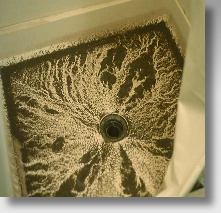Sewage Floods
CERL, Inc
ENVIRONMENTAL CONSULTANTS
Excerpt from:
Suggested Guidelines for Remediation of Sewage
Damage from Sewage Backflow into Buildings
Michael A. Berry, Ph.D.; Jeff Bishop; Claude Blackburn; Eugene C. Cole, Dr.P.H.; William G. Ewald; Terry Smith; Nathan
Suazo; and Steve Swan. Mr. William G. Ewald Health Scientist Environmental Criteria and Assessment Office, U.S.
Environmental Protection Agency (MD-52) Research Triangle Park, NC 27711
Introduction
"--------.
Sewage poses a very significant threat to human health. However, the severity of the health threat depends on the content of
the sewage and the degree and extent of penetration into the building environment. The degree of penetration is dependent
on the porosity of contaminated materials, the quantity of sewage, and the amount of time the sewage remains in contact
with materials. Consider three examples of sewage spilling into an indoor environment; the restoration response may be
different in each situation.
Situation 1. A very limited quantity of waste that originates in the built environment is deposited or flows slightly beyond
the confines of the sewage system. In this situation, the waste is found in one specific location, is contained, and does not
penetrate the building structure. A limited amount of contact time has occurred. An example of this situation might be waste
that overflows in a bathroom and is deposited on and confined to a tile floor. In this situation, there is a limited quantity of
waste, which is contained and does not contact absorbent materials. Decontamination, which includes water extraction,
cleaning, and disinfection, can be effective in reducing this particular potential health risk.
Situation 2. Waste that originates in the built environment is deposited or flows beyond the confines of the building's
disposal system. In this case, there is limited or confined flooding, but water and waste penetrate the structure and
furnishings of the building. For example, flooding occurs in a men's room of an office building, water flows under a wall and
into the carpet of an adjacent hallway. In this case, there is a limited amount of waste that is confined to a relatively small
area of the building, but it penetrates regions of the environment that have complex surfaces and are difficult to restore.
Effective restoration involves decontamination (as in Situation 1) as above and drying all surfaces that have been in contact
with the sewage. In the case of stretch-in carpet, lifting and cleaning the contaminated carpet, disposing of the cushion, and
treating both sides of the carpet thoroughly with a disinfectant are all necessary. Affected porous wall materials need to be
treated with a disinfectant and evaluated for replacement. Because of the confinement of the sewage spill, aggressive,
comprehensive treatment can be effective.
Situation 3. Waste that originates in the built environment, along with other wastes from the main line of the sewage
system, is backed up into the immediate environment, where the waste is widely dispersed and penetrates both the structure
and its furnishings. In this situation, there is extensive risk because humans can be exposed to pathogenic raw wastes that
have penetrated and become contained by the building and its furnishings. If flooding is from this kind of primary outside
sewage system, occupants should be evacuated, and restoration should begin immediately. In this situation, cleaning and
restoration professionals should be protected by using respirators with high-efficiency particulate air (HEPA) cartridges,
rubber boots, gloves, splash goggles, and protective garments. Extreme care should be taken to avoid puncture wounds
during the restoration process. Restoration staff who have cuts or open sores should not be allowed to work on this kind of
restoration project. The principles of restoration of this situation are outlined in the last section of this paper, which contains
specific recommendations for techniques. The main discussion of this paper focuses on the potential health risks posed by a
sewage backup similar to Situation 3.
Description of the Primary Problem
When a building is contaminated with sewage backing up from the septic lines, or flooding of a
building occurs that involves sewage or a heavy load or organic matter, as in the case of river
flooding, a serious threat to human health exists. Without appropriate action, extensive damage to materials will occur
immediately or in time. Several days may elapse before the cause of the backup is determined, the problem is corrected,
and flooding subsides. This allows extensive permeation and contamination of absorbent (hygroscopic) materials such as
wood, gypsum, paper, and concrete to occur. This penetration with water and organic matter leads to the growth of
potentially disease-causing (or opportunistic) microorganisms. These Organisms may pose a serious health risk to occupants
of the building. Organic matter and water-saturated materials can be used as substrate for growth of microorganisms (such
as gram-negative bacteria and toxigenic fungi) that can produce substances toxic to humans and damaging to materials. A
large amount of water inside a building will cause high humidity, which can also contribute to microbial growth on structural
materials and contents. -----."
CERL can provide pre- and post remediation inspection and testing using sampling methods consistent with standard
industry protocols. Sampling is conducted to determine the level and locations of contamination before remediation; and,
after remediation testing to show the effectivness of the clean-up.



